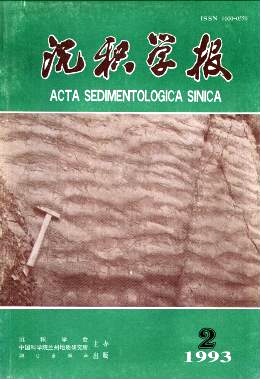Types and Reservoiring Performance of Dolostones of the Lower Paleozoic in Eastern North-China Platform
- Received Date: 1991-05-11
- Publish Date: 1993-06-10
Abstract: Dolostones are very common in the Lower Paleozoic of eastern North-China Platform, and can be divided into mud-silt-sized crystalline dolostones and fine-coarse crystalline dolostones. The former includes gypsiferous and non-gypsiferous; the later includes equal-crystal and unequal-crystal fine-coarse crystalline dolostones. Gypsiferous mud-silt-sized crystalline dolostones are well laminated,show bird's-eyes and mudcracks,contain gypsum crystals or nodules,and are associated with chicken-wire or laminated gypsum rocks. Based on the analysis of two samples,their δ13C is 0. 42‰-2. 21‰, average 1. 13‰(PDB) ;δ18O is -6. 01‰-4. 77‰, average -5. 39‰(PDB). The low δ18O results from recrystallization in fresh water and/or under high temperatures. These dolostones are similar to the Sabkha penecontemporaneous dolostones in the Persian Gulf,and are formed in supratidal flats by evaporative pumping dolomitizatiom under arid climate. Non-gypsiferous mud-silt -sized crystalline dolostones are similar to the gypsiferous ones in texture and structure, but do not contain gypsum and are not associated with gypsum rocks. Based on the analysis of 17 samples,their δ13C is -3. 69‰-3. 41‰,average 0. 03‰;δ18O - 8. 17‰-4. 04‰,average -5. 91‰. The low δ18O also results from recrystallization in fresh water and/or under high temperatures. These dolostones are similar to the supralittoral penecontemporaneous dolostones on the Bahamian Platform, and are formed in supratidal flats by evaporative pumping dolomitization under humid climate. Equal-crystal fine to coarse crystalline dolostones are composed of dolomites of basically the same size. Euhedral and semi-euhedral dolomites are common,especially when dolomitization is incomplete. Some dolomites show dirty centers and clean marging,and may contaim calcite inclusions. Thses dolomites are formed directly by replacing limestones. Based on analysis of 15 samples,the δ13C is -2. 11‰-2. 10‰,average -0. 40‰;δ18O -8. 49‰-4. 09‰,average -5. 53‰. These dolostones are mostly distributed under the disconformity between the Lower and Middle Ordovician,and are formed by dorag dolomitization. Unequal-crystal fine-coarse crystalline dolostones are composed of dolomites of greatly different size. The dolomites are commonly anhedral. Based on analysis of 5 samples,the 513C is -4. 72‰~-1.08‰,average -2. 83‰;δ18O - 9. 27‰~- 7. 32‰, average -8. 31‰. These dolostones are formed by recrystallization of earlier dolostones in fresh water. Porosities of dolostones in the Lower Paleozoic can be divided into intracrystal pores,in-tercrystal pores,vugs,cast pores,fissures,bird's-eye pores and shrinking fissures. The reser-voiring performance of the dolostones are controlled by many factors,such as the content and size of dolomites,and clay content of the dolostones, non-clayey silt-sized crystalline dolostones show the best reservoiring performance.
| Citation: | Jin Zhenkui, Feng Zengzhao. Types and Reservoiring Performance of Dolostones of the Lower Paleozoic in Eastern North-China Platform[J]. Acta Sedimentologica Sinica, 1993, 11(2): 11-18. |






 DownLoad:
DownLoad: